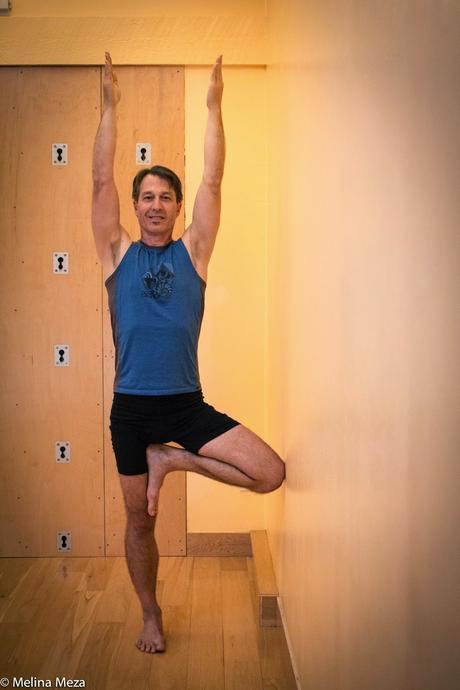
Tree Pose with the Wall
Because the ability to balance changes as we age, and poor balance is at the top of the list of risk factors for an increased chance of falling, it is obvious that maintaining and improving balance is a worthy endeavor! For almost everyone I talk to about their goals as they age, staying independent in function and lifestyle is at the top of their list. Sadly, at the extreme, poor balance often leads to unexpected falls, which can result in devastating fractures and loss of both physical function and being able to live independently. But deteriorating balance can just as easily erode the ability to go about your daily activities with ease and to engage in healthy physical activities. I am sure many of you have friends or family members whose changing ability to balance gradually kept them home bound and had a negative impact on their quality of life. That's why we consider balance as one of the four essential skills of Yoga for Healthy Aging.Aging Changes to Our Balance SystemBefore getting into the ways yoga can maintain and improve balance, it is worth reviewing how balance changes as we age, in an honest light. In our post Aging and Balance, Shari Ser, who both a physical therapist and a yoga teacher, said:“Unfortunately decline in ability to balance is part of ‘normal aging.’ Physiological changes inevitably occur in aging; the composition of the muscle fibers changes from fast twitch to slow twitch, which means our reaction times decline. There are changes in peripheral nerve conduction speeds, and we may either overcompensate or under compensate when our balance is challenged. The smooth modulation of our central nervous system is affected as we age. There are intricate feedback systems between our cerebellum, brain stem, cranial nerves, and basal ganglia that need to be working smoothly for us to easily execute our locomotion and peripheral body through space. Our proprioception (the ability to sense where we are in space) also changes as we age as well as our vestibular system (the balance system that is our inner ear). Some hypothesize that this is due to circulatory changes as we age. There are changes in our auditory and visual systems as we age. We get stiffer in our joints and muscles so we loose the full range of motion these joints may have had previously. Cognitive changes occur in our brain also slowing down the in streaming of information. Balance is a reflexive activity, an unconscious response to a change in stimuli, but to improve balance also requires mental concentration.”How Yoga HelpsIn that same post, Shari suggested some ideas on how yoga helps maintain or improve our balance: “The maxim “use it or you loose it” is so true with balance! But if we stand in Tadasana (Mountain Pose) we are integrating every single one of our balance systems. Our eyes orient us to midline and to the horizon, and they tell us where up and down are. Our vestibular system tells us that the surface is stable and there is no spinning or tilting to compensate for. Our proprioceptors in our joints, muscles, and skin send feedback to the resistance of the floor, and our conscious mind sends information to elongate here, relax there, shift to the right/left, etc. Our brain is never quiet in Tadasana, always tweaking a little bit here and there. The act of standing still is a full body isometric activity, and it is work that is making our bodies stronger.” We can challenge our bodies even more when we stand on one foot, balance on one foot and a hand, such as with Half Moon pose (Arda Chandrasana), or move through a series of connected postures, as in Sun Salutations, because balance and agility are intimately interconnected. In fact, agility requires balance in motion. As Leslie Kaminoff observes, as we move through our day, it is as if we are almost falling and self-correcting moment by moment, and our balance system is what keeps us upright. By engaging in stimulating all aspects of our balance system to work at optimal levels, a regular yoga practice has the potential to influence all of the aging changes Shari outlined above. With yoga, you can:- Stimulate the pressure receptors and proprioceptors in your feet by working barefoot in balance poses barefoot.
- Stimulate the mechanoreceptors in our joints, ligaments, tendons, and muscles above the feet via the various positions in which you place your limbs during yoga asana.
- Improve mental focus by training your minds to return again and again to the balancing task at hand. You notice shifting sensations, the feeling of being on or off balance, when extraneous thoughts take you away from your focus on balance, and so on. Even the pranayama and meditation practices you do can lead to improved mental focus when you find yourself doing balancing poses or walking around the house.

